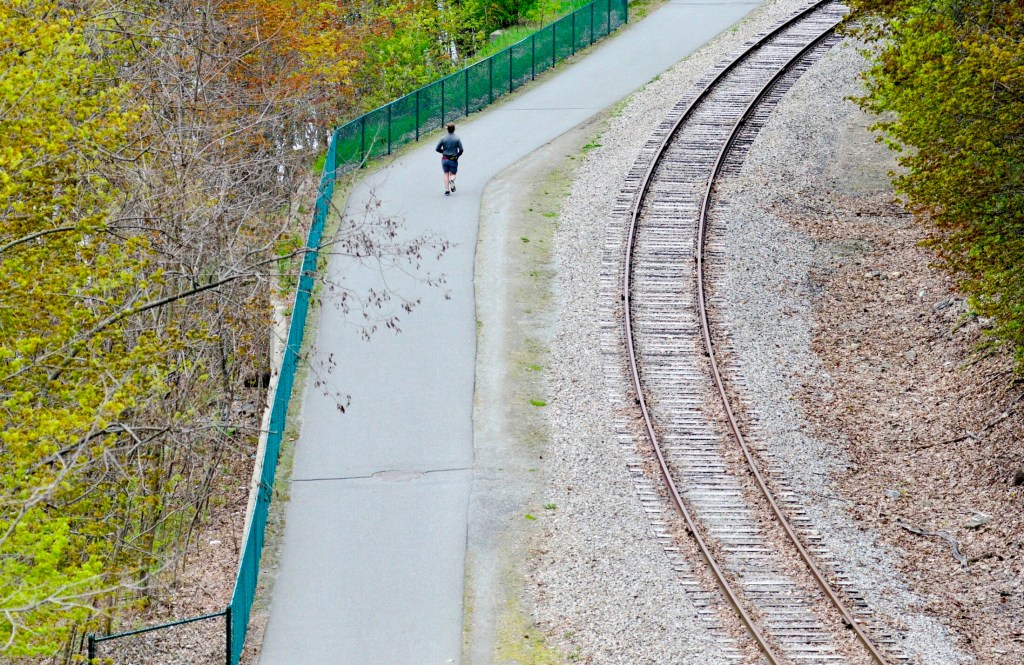The current moves by Merrymeeting Trail proponents to convert the dormant railroad corridor between Gardiner and Topsham from railroad to trail use sharply focuses a clash of visions for the future of this corridor.
On the one hand, passenger rail proponents see in the corridor’s future a revival of passenger rail service through Augusta, Waterville and Bangor, not only for year-round, 24/7, all-weather public transportation, but also as a powerful driver of economic development throughout the region it serves, as Amtrak’s Downeaster now stimulates development from Brunswick southward.
The opposing view would usurp this corridor for a pedestrian and bicycle trail, usable by those with the health and leisure to enjoy it as a linear playground for recreation, and with its use governed by favorable conditions of season, weather, daylight, weekends and vacations.
In a recent newspaper article, trail proponents maintained that the trail could serve as a greater economic stimulus compared to restoring passenger rail service on the corridor, as the latter would end up costing people more than it would give them in economic benefits (“Merrymeeting Trail, connecting Gardiner to Topsham, gets Hallowell council’s support,” May 18).
However, while a feasibility study would need to be completed to determine what it would actually cost to restore passenger rail service, the economic benefits would far out way what walkers and cyclists would ever spend utilizing the proposed trail.
In addition to the initial jobs and investment from construction and ongoing operation, a new passenger rail service to Augusta, Waterville and Bangor would address a number of issues that are outstanding and would contribute to an array of economic benefits.
Maine is demographically the oldest state in the nation, and 56% of Mainers live in rural areas. This cohort needs greater mobility options.
Rail service will also provide greater mobility for commuters working in state government in Augusta and for many of the 47,000 students who attend the University of Maine in Orono and the other nine schools of higher education in central Maine.
The potential economic benefits include increased tourism and visitor spending and increased business activity in sectors that support tourism and transportation. Rail would also promote economic development, which would attract millennials and families who no longer can afford housing in southern Maine.
The return of passenger service would also play an important role in confronting environmental challenges. It could improve air quality, reduce greenhouse gas emissions, facilitate compact development, conserve land and decrease travel demand and save energy.
While there are many examples of economic development taking place all across the nation as passenger rail service is restored, we don’t need to look beyond Maine to discover what has been happening. Brunswick residents have seen first hand how restoring passenger service is an investment in their future. A once-barren Brownfield site located between downtown Brunswick and Bowdoin College has been transformed into the bustling Brunswick Station. The complex includes restaurants, medical offices, retail shops, a visitors center and a 52-room hotel along with the train station adjacent to the train platform.
An economic resurgence is also taking place in Saco. An old tannery mill across the street from the Amtrak station has been converted into a mixed-use development that includes 150 apartments and 4,000 square feet of commercial space.
Close proximity to the transportation center in Portland is also a huge factor in the ongoing development of Thompson’s Point. Developers say the site has become “a hub of creative activity: brewers, restaurateurs, designers, musicians, and makers have set up shop in the site’s once forgotten buildings.” It is poised “to become a new center for residential and commercial activity, with plans for a hotel, children’s museum, recreational opportunities that take advantage of the water and trails nearby, homes, office spaces, and shared green space.”
It is also a mirage to believe that the existing track between Gardiner and Topsham, if covered or removed, can be restored to safe passenger train conditions, either because of accelerated deterioration of ties and rail, or by resistance of trail interests once established.
Although isolated parts of the corridor may allow railroad operations and trail to co-exist safely, single track bridges, clearances, drainage, operation and maintenance, and trespass avoidance issues demand separation distances that the corridor cannot safely accommodate throughout its full length.
Displacement of railroad use for a trail at any point throughout the Gardiner-Topsham corridor will eliminate the potential to restore passenger rail service to and through Maine’s capital city of Augusta for the foreseeable future.
Richard Rudolph, Ph.D., is chairman of the Rail Users’ Network. Jack Sutton is former president and current director of Maine Rail Group.
Send questions/comments to the editors.



Success. Please wait for the page to reload. If the page does not reload within 5 seconds, please refresh the page.
Enter your email and password to access comments.
Hi, to comment on stories you must . This profile is in addition to your subscription and website login.
Already have a commenting profile? .
Invalid username/password.
Please check your email to confirm and complete your registration.
Only subscribers are eligible to post comments. Please subscribe or login first for digital access. Here’s why.
Use the form below to reset your password. When you've submitted your account email, we will send an email with a reset code.